Projected Trends and Statistics for Health and Safety in Winnipeg
Key Insights
| According to Manitoba’s Annual Statistics for 2021, cancer is the primary cause of death in Winnipeg, accounting for 32% of all reported deaths. Statistics Canada shows that from 2010 to 2012, Winnipeg had a mortality rate of 7 deaths per 1,000 people. The Canada Crime Index shows that Lord Selkirk Park is the most violent neighborhood in Winnipeg, with 2,500 crimes per 100,000 individuals. Data from the Manitoba Health Provincial Information Management and Analytics report illustrates that Winnipeg has an infant mortality rate of 4 per 1,000 live births. Diabetes Canada reveals that complications with diabetes cost Manitoba’s healthcare system millions of dollars annually, due to direct medical costs and indirect losses from work, disability, and premature death. |
The province of Manitoba’s Annual Statistics for 2021 reveal data on the health of residents in the area.
Recent mortality statistics show that cancer is the primary cause of death in the region, accounting for 32% of all reported deaths.
This is followed by circulatory diseases, which include illnesses like heart attacks, strokes, and other cardiovascular conditions. These are responsible for 19.9% of the total mortality rate.
Injuries are the third most common cause of death in the city, accounting for 11.3% of the total. This category consists of both unintentional injuries, like road and fall accidents, and intentional ones, like self-inflicted harm or assault.
Meanwhile, ill-defined signs and symptoms cause 10.3% of deaths. This category includes instances in which the particular cause of death could not be easily determined, often due to a lack of medical documentation.
Furthermore, respiratory diseases are responsible for 5.5% of deaths in the city. This covers chronic diseases such as Chronic Obstructive Pulmonary Disease (COPD) and acute diseases like pneumonia.
On the lower end of the list, digestive system diseases account for 4.8% of the total number of deaths, while endocrine and metabolic disorders like diabetes cover 4.1%.
Disorders of the nervous system, including diseases of the brain, cover another 3.4% of the total. Meanwhile, mental and behavioral disorders, including substance use, addiction, and psychiatric diseases, account for 1.8%.
Infectious and parasitic diseases, such as sepsis, influenza, and other communicable diseases, make up another 1.4%.
It is also important to note that other causes of death, which are those not mentioned in the list, are 5.6% of the total.
| Cause of Death | Share of Total Deaths (%) |
| Cancer | 32.00% |
| Circulatory Diseases | 19.90% |
| Injuries | 11.30% |
| Ill-Defined Signs and Symptoms | 10.30% |
| Other Causes | 5.60% |
| Respiratory Diseases | 5.50% |
| Digestive System Diseases | 4.80% |
| Endocrine and Metabolic Disorders | 4.10% |
| Nervous System Disorders | 3.40% |
| Mental and Behavioral Disorders | 1.80% |
| Infectious and Parasitic Diseases | 1.40% |
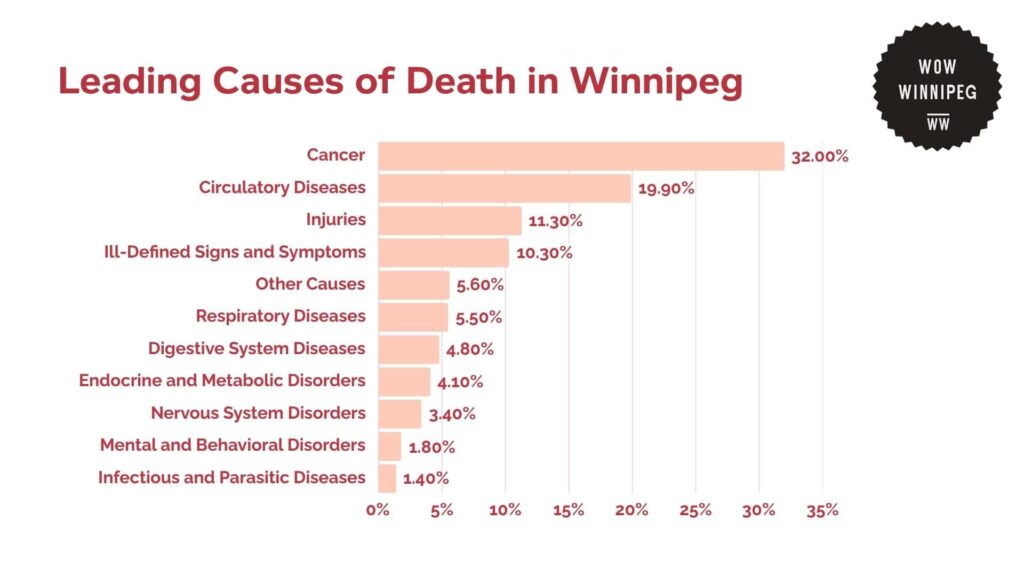
Regional Analysis of Health and Safety Trends Across Canada
Data from Statistics Canada shows how the premature mortality rates in large Canadian urban centers differ greatly, mostly because of their varied health systems, population composition, and socioeconomic context.
From 2010 to 2012, the city of Winnipeg had a mortality rate of 7 deaths per 1,000 population. This rate puts Winnipeg among the higher-ranking cities across Canada.
Toronto, Calgary, Ottawa–Gatineau, and Edmonton each have 6 per 1,000 reported mortality rates. This means that Winnipeg’s rate is 16.7% greater than the rates of these four cities.
The lower rates for these cities may be the result of a higher availability of specialized healthcare or more comprehensive public health programs addressing preventable diseases.
However, Winnipeg’s premature mortality rate is comparable to Vancouver, Montreal, Hamilton, and Halifax, each of which also reported 7 deaths per 1,000 population.
These cities have some of the same attributes as Winnipeg, including aging populations, urban density, and a combination of issues in their healthcare systems that likely cause similar burdens.
Finally, Quebec City has the highest mortality rate of the surveyed cities, at 8 per 1,000 population. This is 14.3% above Winnipeg’s rate.
Quebec City’s high rate may have been caused by an older population profile or particular local health issues. This includes a greater incidence of certain diseases or limited access to healthcare.
| Areas | Mortality Rate (per 1,000 population) |
| Quebec City | 8 |
| Vancouver | 7 |
| Winnipeg | 7 |
| Hamilton | 7 |
| Halifax | 7 |
| Montreal | 7 |
| Calgary | 6 |
| Ottawa–Gatineau | 6 |
| Edmonton | 6 |
| Toronto | 6 |
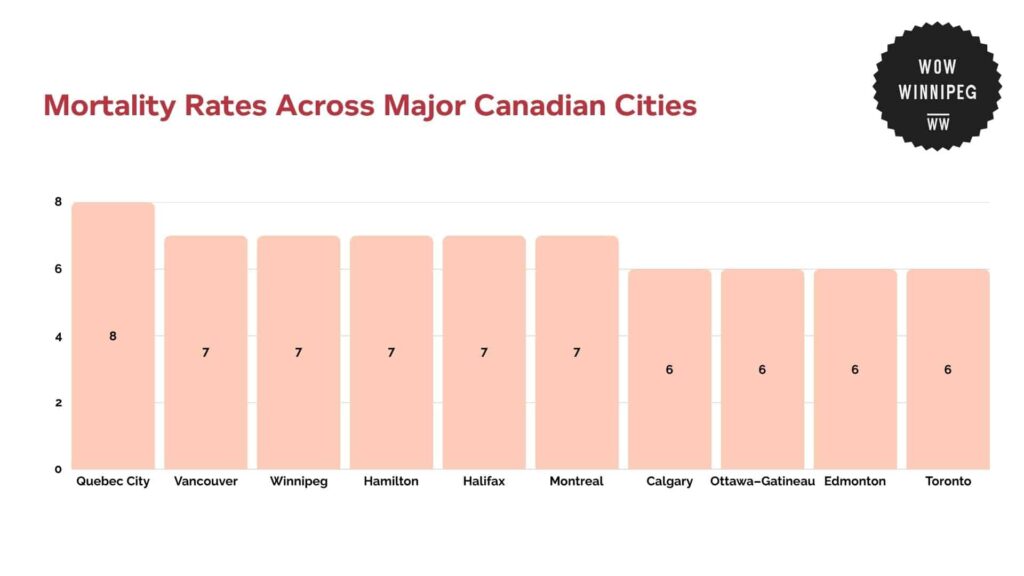
Top 10 Most Violent Neighborhoods in Winnipeg
Data from the Canada Crime Index identifies the top 10 neighborhoods in Winnipeg with the highest crime rates in 2025.
The ten highest violent crime neighborhoods all experience between 2,375 and 2,624 incidents per 100,000 residents.
Thus, these neighborhoods have a violent crime occurrence between 42% to 56% higher than the city average of 1,682 incidents per 100,000 people.
Lord Selkirk Park is Winnipeg’s most violent neighborhood, with 2,624 crimes per 100,000 individuals, which is 56% above the city average.
This indicates individuals residing in this community are at greater risk of being victims of assaults, robberies, or other violent offenses than those who live elsewhere in the city.
Central Park is the next highest at 2,589 violent offenses per 100,000 population, which is 54% higher than the Winnipeg rate. William Whyte is not far behind with 2,548 occurrences, or 52% higher than the citywide average.
These three areas are close to the downtown center and have long been experiencing issues related to socioeconomic inequality, housing instability, and inability to access services like healthcare.
Meanwhile, Centennial recorded 2,523 violent crimes for every 100,000 residents, which is 49% above the city average.
The rates for Dufferin and North Point Douglas were both 49% higher than the city average, with 2,241 and 2,641 cases, respectively.
This is followed by Portage – Ellice at 2,475 cases, which is 47% higher than the city’s average.
These neighborhoods frequently deal with combined challenges such as homelessness, addiction, and limited availability of inexpensive housing, which are all possible causes of higher violence rates.
Spence places eighth at 2,469 incidents per 100,000 residents. This is 47% higher than the Winnipeg average. Logan C P R ranks next at 2,424, or 44% higher.
Finally, Dufferin Industrial recorded 2,375 violent offenses per 100,000 residents, which is still 42% higher than the Winnipeg average.
These numbers show that some areas in Winnipeg face much more violence than others, and illustrate the link between safety and socioeconomic contexts in the city.
| Rank | Neighborhood | Violent Crimes per 100,000 People | Compared to City Average |
| 1 | Lord Selkirk Park | 2,624 | 56% higher |
| 2 | Central Park | 2,589 | 54% higher |
| 3 | William Whyte | 2,548 | 52% higher |
| 4 | Centennial | 2,523 | 50% higher |
| 5 | Dufferin | 2,241 | 49% higher |
| 6 | North Point Douglas | 2,641 | 49% higher |
| 7 | Portage – Ellice | 2,475 | 47% higher |
| 8 | Spence | 2,469 | 47% higher |
| 9 | Logan – C.P.R. | 2,424 | 44% higher |
| 10 | Dufferin Industrial | 2,375 | 42% higher |
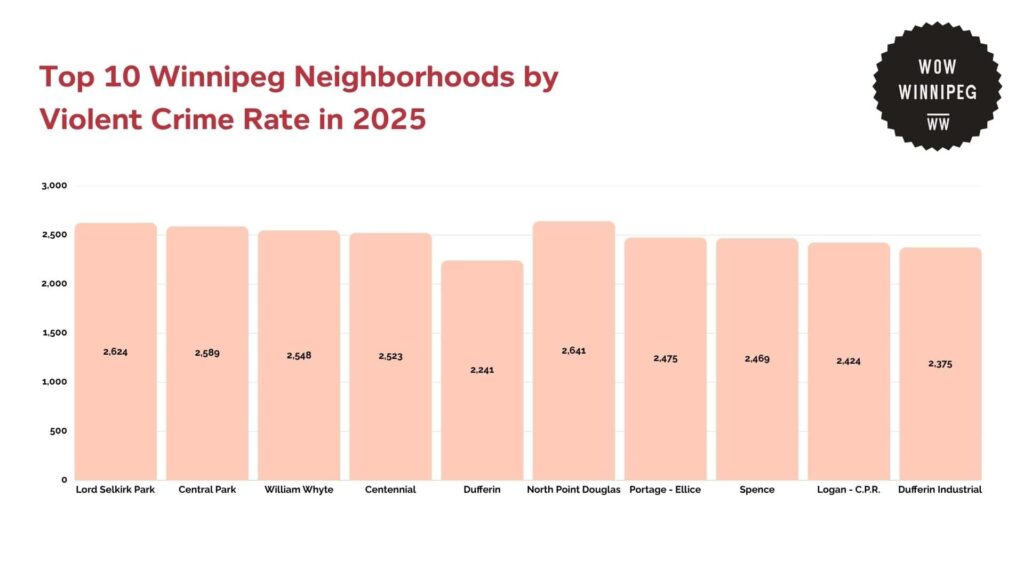
Demographic Breakdown of Mortality Rates Across Manitoba
Statistics from the Manitoba Health Provincial Information Management and Analytics Report reveal valuable insights into the province’s mortality statistics.
Premature Mortality Rates in Manitoba
Premature mortality refers to deaths that occur before the age of 75. It is often used as a general measure of health outcomes and access to healthcare in the community.
In Manitoba, premature mortality rates vary widely by region. The Northern region has the highest premature mortality rate, with 8 deaths per 1,000 residents.
This is 166% higher than the rate for Winnipeg, which is at 3 premature deaths per 1,000 residents.
Similarly, Interlake–Eastern follows with a premature mortality rate of 4 per 1,000 residents. This is 33% higher than Winnipeg’s rate.
Prairie Mountain, Southern, and Winnipeg all share the same rate of 3 per 1,000 residents.
These three regions have the lowest premature mortality in the province, suggesting more stable access to health services and stronger community health indicators.
The difference between regions highlights long-standing healthcare issues across Manitoba, with more barriers present in the northern regions.
| Region | PMR (per 1,000 residents) |
| Northern | 8 |
| Interlake-Eastern | 4 |
| Prairie Mountain | 3 |
| Winnipeg | 3 |
| Southern | 3 |
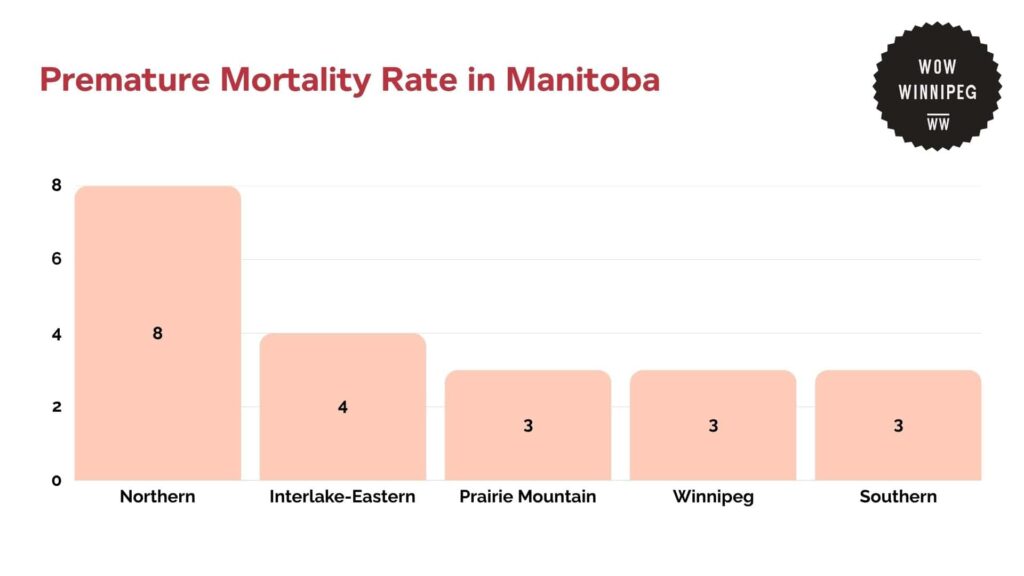
Infant Mortality Rates in Manitoba
Infant mortality measures the number of deaths among infants under one year old for every 1,000 live births. This is another important indicator of a region’s overall health, especially for maternal care, newborn services, and living conditions.
The Northern region reports an infant mortality rate of 9 deaths per 1,000 live births. This is more than double the rate in Winnipeg, which is at 4 deaths per 1,000 live births.
Moreover, compared to Winnipeg, the Northern region’s infant mortality rate is 125% higher. This sharp difference suggests deeper issues in access to prenatal care, birth support, and healthcare services in the northern communities.
The Interlake–Eastern, Prairie Mountain, and Southern regions each report an infant mortality rate of 5 per 1,000 live births.
Although lower than the Northern region, they still reflect a gap that may be linked to healthcare shortages, rural barriers, or socioeconomic issues.
Finally, Winnipeg’s mortality rate of 4 deaths per 1,000 live births is the lowest in the province. This figure may reflect better access to hospitals, neonatal care units, and trained healthcare professionals in the city.
| Region | Infant Mortality Rate (per 1,000 live births) |
| Northern | 9 |
| Interlake-Eastern | 5 |
| Praire Mountain | 5 |
| Southern | 5 |
| Winnipeg | 4 |
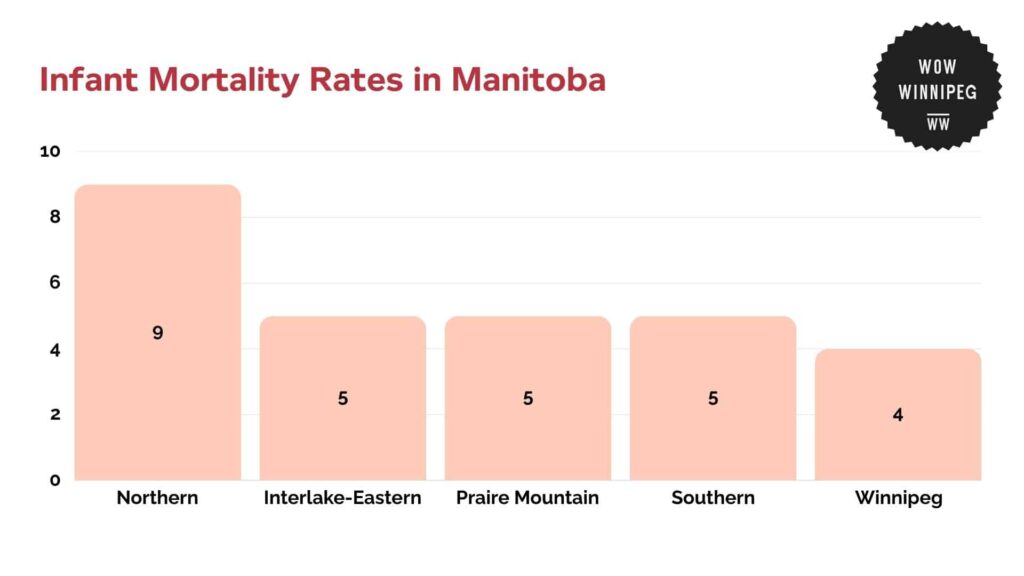
Costs and Consequences of High Mortality Rates in Winnipeg
Strain on the Healthcare System
The Government of Manitoba shows how rising mortality rates put an increasing strain on the city’s healthcare system.
Long-term illnesses such as cancer and circulatory disorders cause more than half of all instances of premature mortality in the region.
With more patients needing to receive long-term treatment for these conditions, hospitals and clinics are compelled to allocate more of their resources to treating these complicated cases.
This strain reduces the healthcare system’s capacity for early intervention and prevention programs, or other services that are also crucial for the community.
For example, emergency rooms are especially impacted by rising mortality rates. This puts more pressure on ambulances, trauma care, and hospital beds, and can cause shortages.
Furthermore, when health facilities are running at capacity, patients experience longer wait times and fewer choices of care. This is especially seen in poorer areas where services are already strained.
Financial Impacts
Outside of hospitals, the financial effect of high mortality extends far into communities. When individuals die prematurely, particularly from avoidable causes, it results in lost earnings, decreased workforce participation, and long-term financial burden for families.
These losses accumulate at the city level, where fewer labor force participants result in lower productivity and slower economic growth.
Diabetes Canada reports that complications of diabetes cost Manitoba’s healthcare system millions of dollars annually. These costs are comprised of direct medical costs and indirect costs of time lost from work, disability, and premature death.
In Winnipeg, the neighborhoods that have poor access to healthcare and greater poverty rates tend to have higher instances of various illnesses. This creates more costs for areas that are already struggling financially.
Thus, rising mortality rates worsen economic inequalities within the city, which makes it even harder for certain areas to improve their healthcare services.
Impacts on Families and Communities
Beyond the obvious impacts of high mortality rates, there is also a need to consider the social and emotional effects on communities.
Families that lose loved ones tend to suffer long-term both emotional trauma and financial hardship.
While its impacts cannot be measured concretely, the effects of grief may also result in mental problems that impact a person’s ability to work effectively, which then impacts their income.
Additionally, families may experience economic losses due to the high costs of healthcare services and funeral expenses.
At the community level, the impact is also severe. High mortality rates in a community can result in lower morale, which affects the mental health and productivity of its residents.
These conditions then make it even more difficult for residents to access proper care or establish stable local healthcare services.
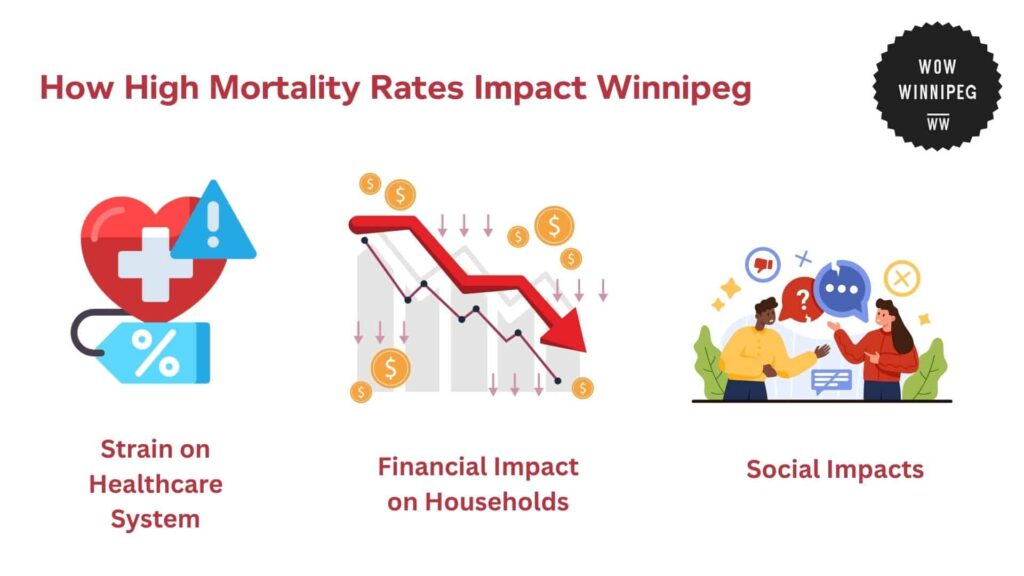
Interventions and Solutions to Rising Mortality Rates in Winnipeg
To improve the overall health of the community, Winnipeg has introduced a number of focused programs on prevention and direct care.
One significant program from the Winnipeg Regional Health Authority is the IMPACT team. This team collaborates with public health agencies, government agencies, and local organizations to decrease injury risk.
The program concentrates on practical safety measures, including preventing older adults from falling, promoting safe cycling behaviors, and enhancing child passenger protection.
Furthermore, in response to increasing levels of violence-related injuries, the city also introduced the Community-Emergency Department Violence Intervention Program, or CEDVIP.
This program serves youth and young adults aged 14 to 29 who are treated in emergency departments after having been injured by violent encounters.
Instead of providing short-term treatment alone, CEDVIP offers continuing assistance to ensure that participants remain safe and free from harm.
Within five months, almost 200 individuals benefited from CEDVIP. In addition to diminishing their risk for further harm, the program also served to decrease repeat visits to Winnipeg’s emergency department.
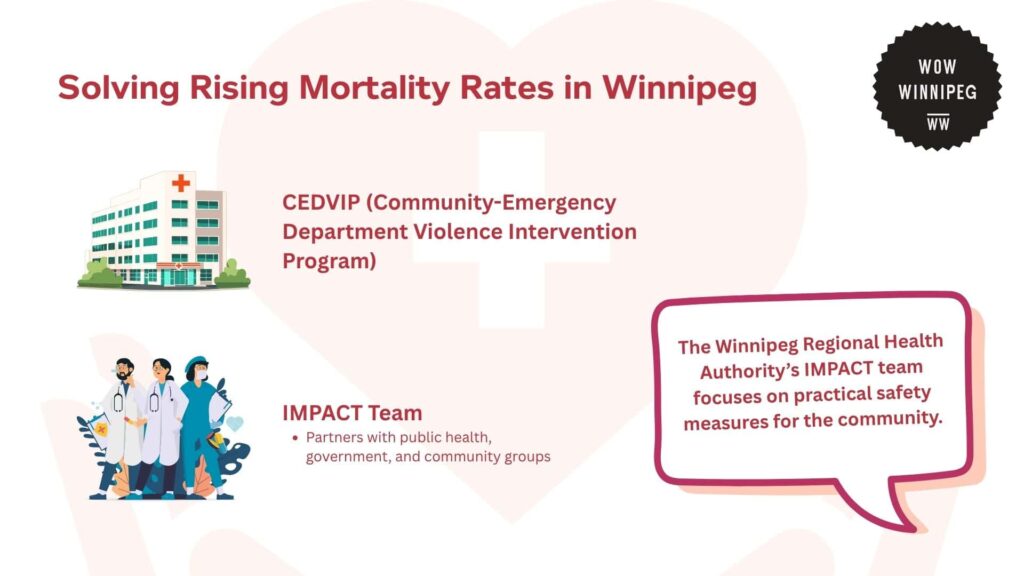
The Future of Health and Safety in Winnipeg
In the future, Winnipeg’s success in reducing mortality rates will rely on how well it improves long-standing health disparities.
Although present statistics indicate that chronic disease, injury, and violence continue to cause premature deaths, the city has also begun taking steps towards strategic intervention.
Initiatives such as CEDVIP and the IMPACT team of the WRHA indicate a movement toward prevention and community care.
If these programs continue to develop and are given long-term support, Winnipeg could experience a reduction in preventable or premature deaths in its communities.
The initial success of CEDVIP, with almost 200 individuals served in five months, is a positive indicator of change for the community.
Overall, Winnipeg’s future health and safety statistics will likely be affected not only by clinical care but also by coordinated investment in premature mortality prevention, improved socioeconomic conditions, and mental health services.
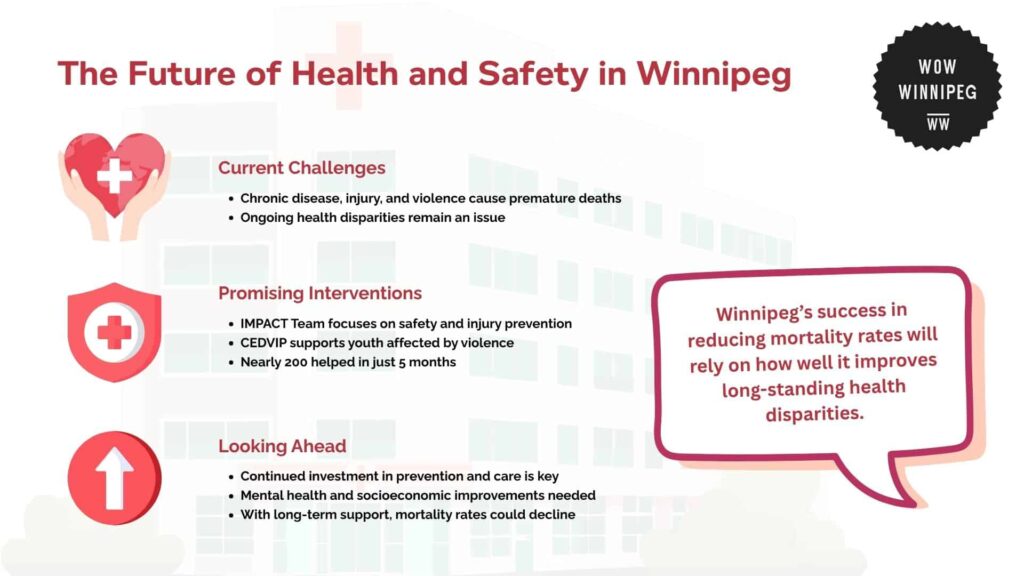
References
- Government of Manitoba. (2021). Annual statistics 2021. Manitoba Health. https://www.gov.mb.ca/health/annstats/as2021.pdf
- Statistics Canada. (n.d.). Table 13-10-0741-01: Deaths and mortality rate, by selected grouped causes and sex (Number and rate per 100,000 population), Canada, provinces and territories. https://www150.statcan.gc.ca/t1/tbl1/en/tv.action?pid=1310074101
- Canada Crime Index. (n.d.). Winnipeg crime rate statistics. https://canadacrimeindex.com/winnipeg-crime-rate/#google_vignette
- Diabetes Canada. (n.d.). Home page. https://www.diabetes.ca/
- Winnipeg Regional Health Authority. (n.d.). Injury prevention. https://wrha.mb.ca/public-health/service/injury-prevention/
- Government of Manitoba. (n.d.). News and media releases. https://news.gov.mb.ca/news/


